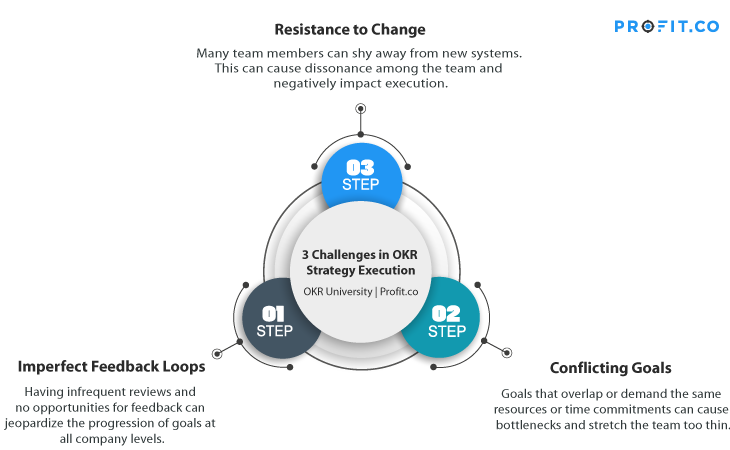Are you looking to implement a new strategy, but aren’t at all sure where to start?
Any research into strategy-execution frameworks has probably brought you to OKRs. OKRs help bridge the strategy-execution gap. You may be asking yourself “How do I get started with OKRs?” or “What if my employees don’t know what I am trying to achieve?”
However beautiful the strategy, you should occasionally look at the results
This article will give you a step-by-step guide to implement an effective strategy with OKRs.
What’s the Deal with OKRs?
What are OKRs? OKRs (Objectives and Key Results) are a framework that helps strategically align people within an organization. OKRs translate long-term strategic goals into focused objectives and measurable key results so that strategy can be executed on the company, department, and operational levels of your organization.
The OKR methodology is based on three core principles: focus, alignment, and feedback
- Focus: Focus means having an idea of what you want to achieve in the future at any given moment.
- Alignment: It is important not just to have one person but rather everyone working together for success.
- Feedback: We cannot measure progress unless we know where we started from. This is why there must always be feedback loops involved to make sure employees understand their progress towards achieving these goals.
OKRs help people on your team or in your department know exactly what they need to do now so that one day you can say “mission accomplished.” That’s why OKRs and strategy implementation go hand-in-hand.
Create an Strategy Implementation Plan Using OKR
OKRs are a great way to translate strategy into smaller, measurable goals which can be operationalized within your team or department.
But how do you get started with an effective OKR?
Step 1: Define your objectives based on strategy
To start the process of implementing your new strategic plan, come up with between three and five objectives. These should align closely with the company’s desired outcomes as outlined in their yearly business plans (which is why these two things should always go hand-in-hand).
Step 2: Define your key results
After you’ve identified the objectives, now it’s time to think of the key results. What are some things that you can measure against these objectives to know if they’re successful? Quality key results should always be mutually exclusive and collectively exhaustive, and you should have between three and five key results for each objective.
Once you’ve identified all those measurable items, now comes the fun part – actually doing them! Make sure you revisit this list every quarter to make any necessary adjustments based on continuous feedback from yourself and your team members.
Establish Specific To-Do Initiatives
As far as OKRs and strategy execution is concerned, the first thing to ask is who should execute these key tasks? The person executing the task must understand them in the first place.
Step 3: Assign your initiatives
The three primary things you’ll want to look at are:
- Who needs what information to get started?
- How much effort will this take from each individual or team member?
- Who is accountable if something goes wrong with one of your goals?
Executing strategies also means you’ll have to give some performance incentives to your employees to get them to do what you need. This is also where OKRs come in handy – they let you know who needs a little extra motivation and how much incentive it will take before this goal becomes reality!
Step 4: Review, review, review
Weekly or monthly reviews are a great way to measure progress and make sure you’re on track with your objectives. Another way is to have a physical wall of OKRs in your office with each person’s objectives and key results posted for all to see. Additionally, using an OKR software to manage and track your goal progress is a transparent way to stay aligned throughout the entire quarter. You can get started on Profit.co’s OKR management software completely free today!
Once you’ve created these tasks, now it’s time to assign people to them! OKRs and communicating strategies run in parallel, so that everyone knows what they’re supposed to do.
3 Challenges in OKR Strategy Execution
OKRs allow you to measure progress on a daily basis, but there are some challenges that come with it as well.
- Feedback loops aren’t perfect. Opportunities for feedback can sometimes be too few and far between, so people don’t really know how they’re doing overall and whether or not their OKRs are being completed successfully. One way to overcome this is by using data visualization, which helps people understand their progress.
- Goals conflict with one another. Another challenge stems from poor goal-setting practices. If key results aren’t mutually exclusive, or if resources were not properly allocated during the planning stage of the quarter, then you’ll start to see lots of issues with your OKR program.
- People are resistant to change. The last challenge is when employees are resistant to change. This can happen as a result of any or all of the previous challenges. Effective communication is key to making sure people know that the change is necessary and will benefit them in the long run.

Tie it All Together with OKR Strategy Execution
OKRs are a great way to bridge the gap between strategy and execution- but it doesn’t do you much good unless your strategy is aligned with what employees care about.
Before you even start implementing, make sure that your strategy is in line with the company’s values and what they want to achieve- otherwise it won’t work.
OKRs align employees to the company’s strategy. This is the key to bridging that gap. One way to do this is by asking employees what they want to accomplish and how it ties in with the company strategy. This can help you determine if any gaps need to be addressed.
If employees don’t see how their contributions and the company’s goals coincide, it could lead to low engagement- which means they won’t execute your strategy well.
Communicating your strategy through your OKRs isn’t just something you do at the beginning of the quarter and then forget about. This must happen consistently over time so all employees understand their role.
Want to learn more about how you can use OKRs to implement your strategy with focus and alignment? Book a free demo with our OKR experts to learn how Profit.co can help you achieve more, more efficiently.
Ready to start your OKR Journey for FREE?

